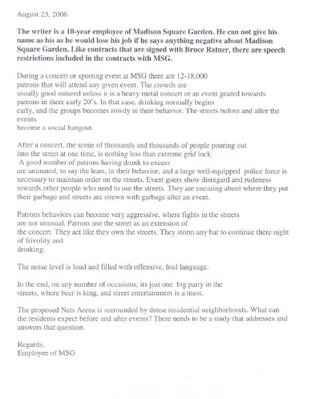Flashback: in 2006 comment, MSG employee warned of rowdy fans, noise; ESDC responded that sidewalks would be fine, crowd noise "masked" by vehicle noise
Tomorrow we're supposed to learn about the Transportation Demand Management plan for the Barclays Center, first at a 9:30 meeting of the Atlantic Yards District Service Cabinet, then at a 6 pm public meeting at Borough Hall.
That plan's been delayed nearly six months, and there are other plans yet unrevealed, such as a code of conduct for the arena.
A warning from a MSG employee
So it's worth looking back to an 11/29/06 post, in which I pointed to an interesting, if anonymous, nugget of commentary emerged from the multitudinous comments filed in response to the Atlantic Yards Draft Environmental Impact Statement (EIS) and included in the Final EIS.
 A ten-year employee of Madison Square Garden warned urgently about noise, rowdy patrons, garbage, and gridlock. (Click to enlarge.)
A ten-year employee of Madison Square Garden warned urgently about noise, rowdy patrons, garbage, and gridlock. (Click to enlarge.)
The writer, who said he could not give his name, because, "like contracts that are signed with Bruce Ratner, there are speech restrictions included in the contracts with MSG." (The latter is unconfirmed, but there is a record of Ratner gag orders.)
The writer warned that, after events with younger crowds, drunk patrons crowd the street and carelessly strew garbage. They also treat the streets like they own them, he said, and are quite loud:
The Final Environmental Impact Statement (EIS) from the Empire State Development Corporation was sanguine about the issue, responding:
 A ten-year employee of Madison Square Garden warned urgently about noise, rowdy patrons, garbage, and gridlock. (Click to enlarge.)
A ten-year employee of Madison Square Garden warned urgently about noise, rowdy patrons, garbage, and gridlock. (Click to enlarge.)The writer, who said he could not give his name, because, "like contracts that are signed with Bruce Ratner, there are speech restrictions included in the contracts with MSG." (The latter is unconfirmed, but there is a record of Ratner gag orders.)
The writer warned that, after events with younger crowds, drunk patrons crowd the street and carelessly strew garbage. They also treat the streets like they own them, he said, and are quite loud:
In the end, on any number of occasions, it's just one big party in the streets...Final EIS sanguine
The proposed Nets Arena is surrounded by dense residential neighborhoods. What can the residents expect before and after events? There needs to be a study that addresses and answers that question.
The Final Environmental Impact Statement (EIS) from the Empire State Development Corporation was sanguine about the issue, responding:
The sidewalks adjacent to the arena block would be wide enough to accommodate the anticipated large volumes of patrons expected for arena events; and publicly accessible amenities, such as the Urban Room with its below-grade connection to the subway, and public plazas along Atlantic and Flatbush Avenues, would be situated around the outside of the arena creating a friendly and interactive pedestrian experience. Thus, although the character of the streets and sidewalks would change through sizable intensification of pedestrian activity, pedestrian congestion would not occur. Pedestrian volume on Dean Street would increase notably, especially prior to and immediately following arena events, as a large portion of the arena parking would be located along Dean Street between Carlton and Vanderbilt Avenues. There would be no planned activities or sidewalk vending associated with the arena use on Dean Street. In general, any crowd noise surrounding the arena would be expected to be masked by noise from vehicles on adjacent streets and would not be a major noise source.(Emphases added)
Can we still believe this?
Today, I'd suggest, the jury is very much out on whether "pedestrian congestion would not occur" and whether crowd noise "would be expected to be masked" by vehicle noise.
Also, given the increase in the number of bars and entertainment outlets near the the arena, there will be a cumulative impact that, in retrospect, should have been predicted and evaluated.
Comments
Post a Comment